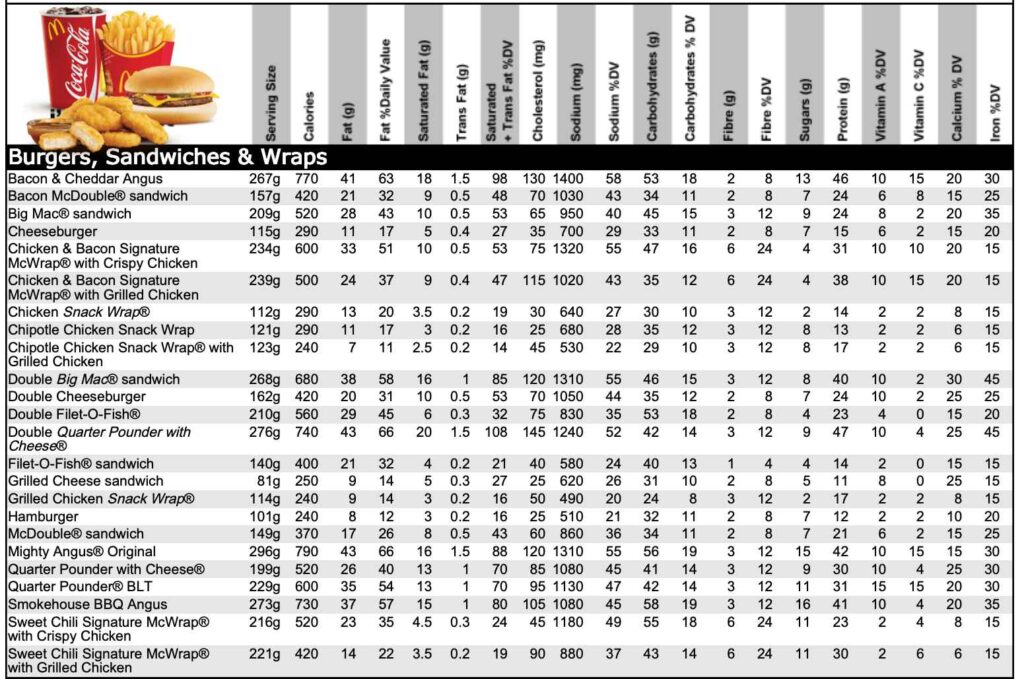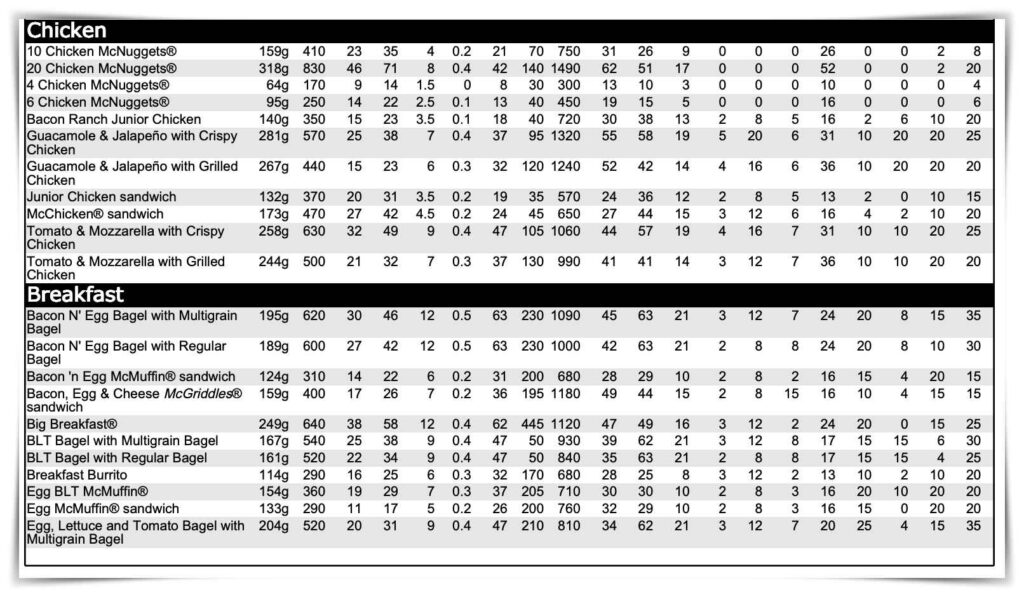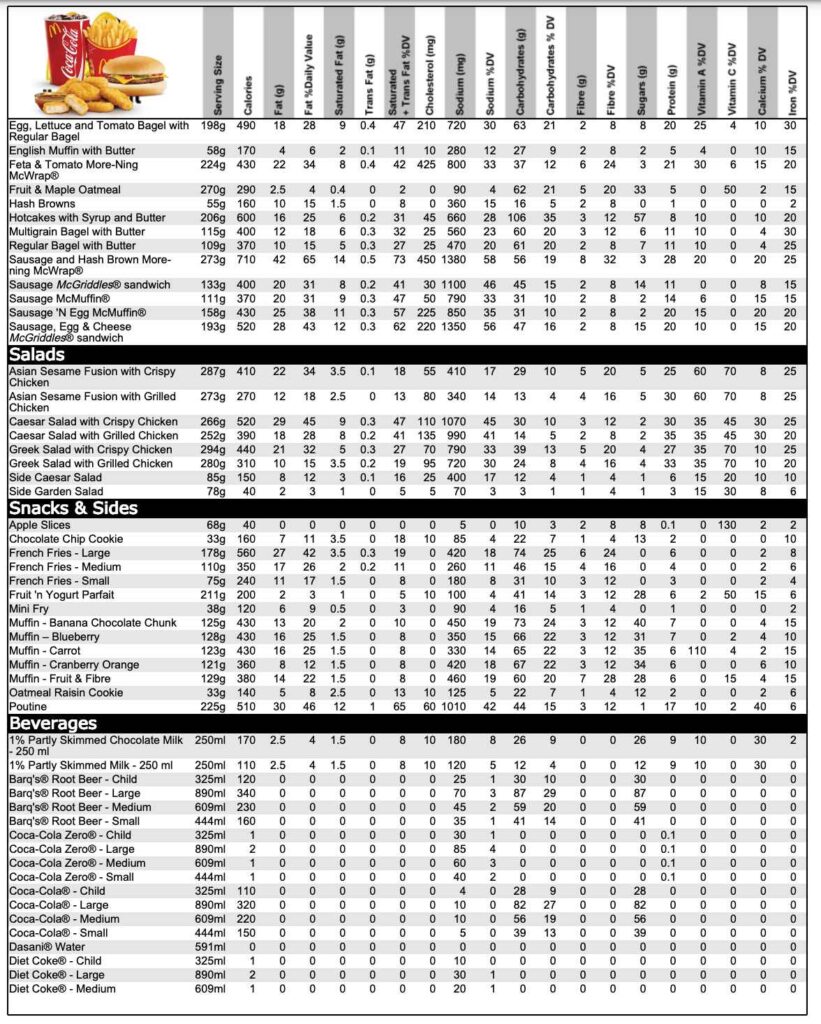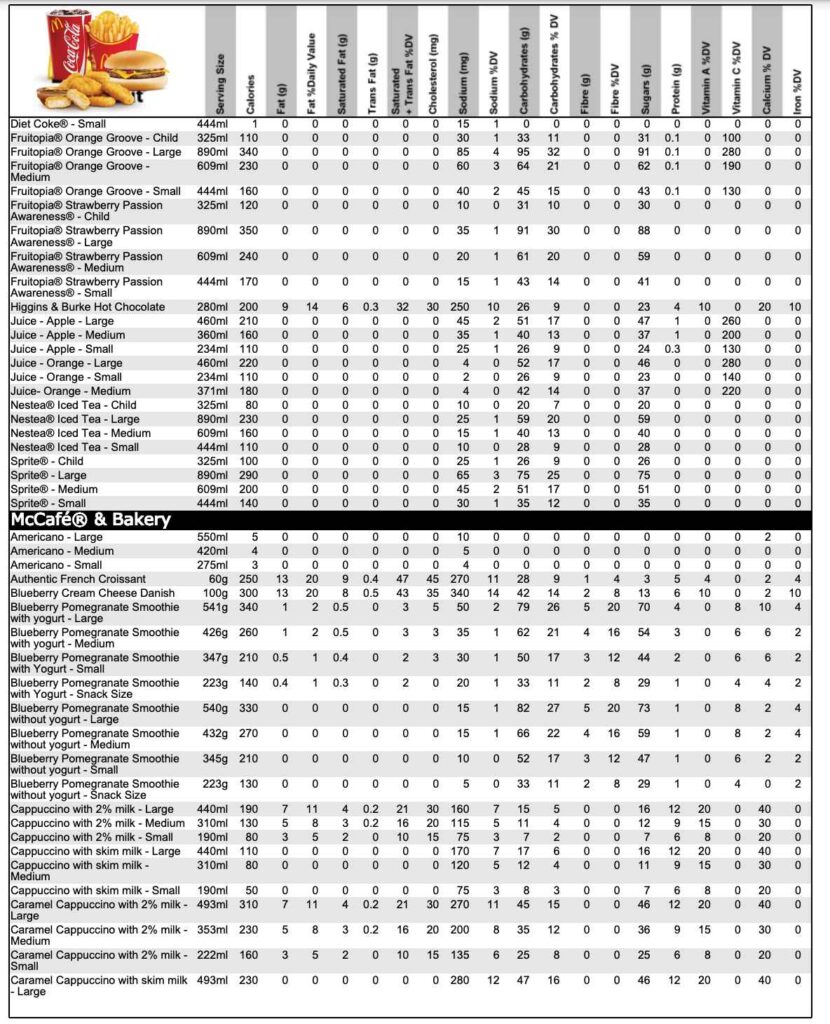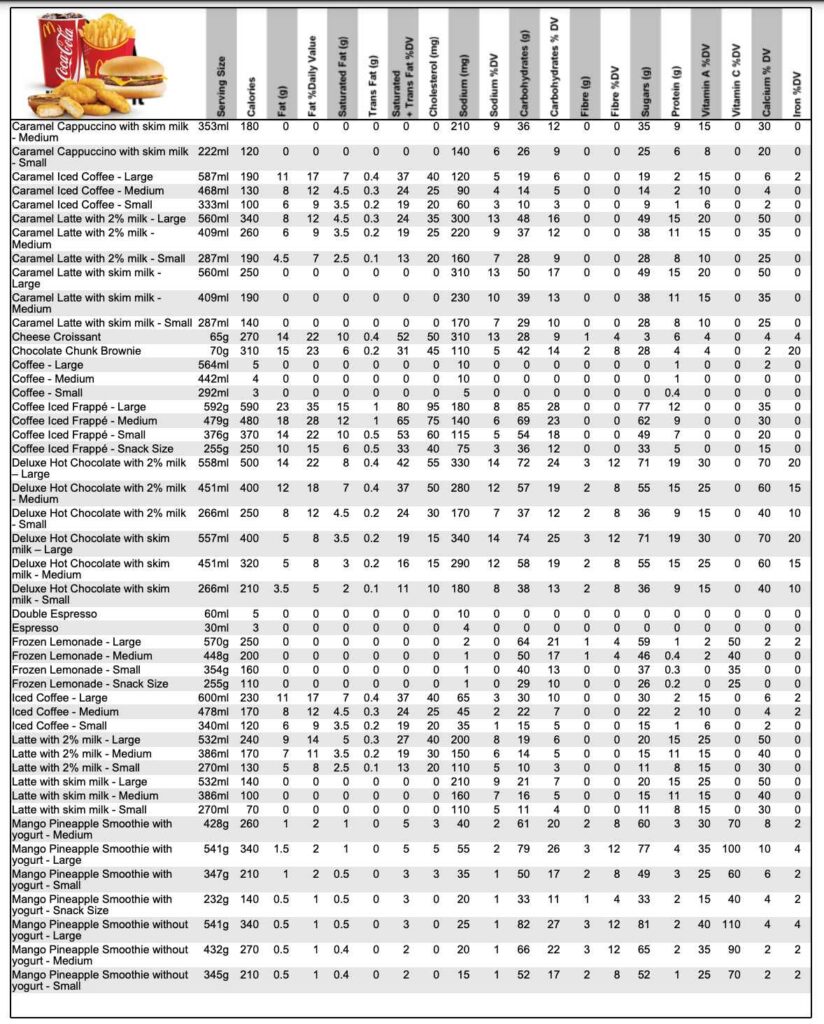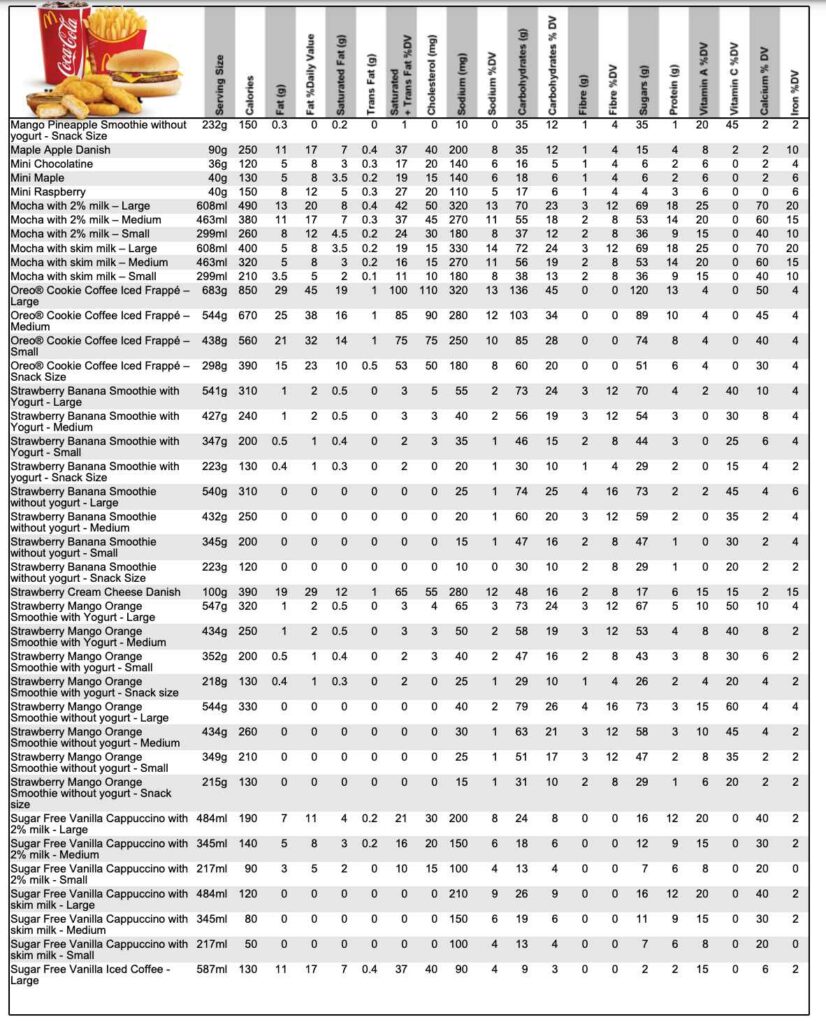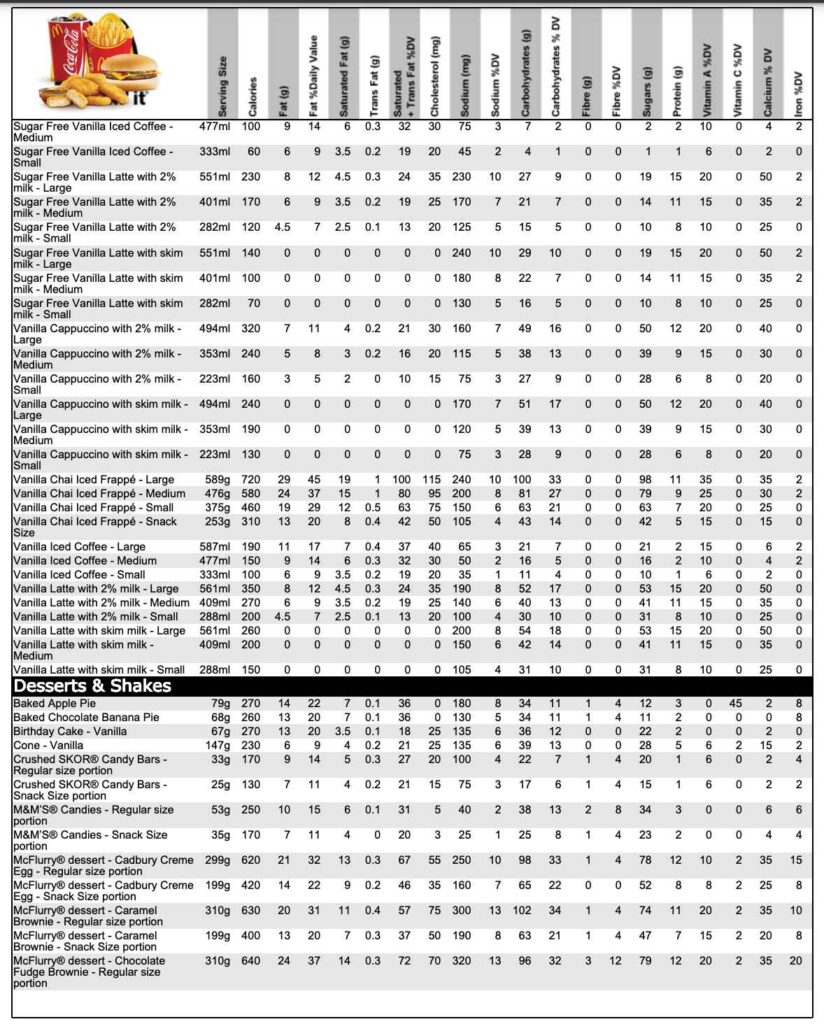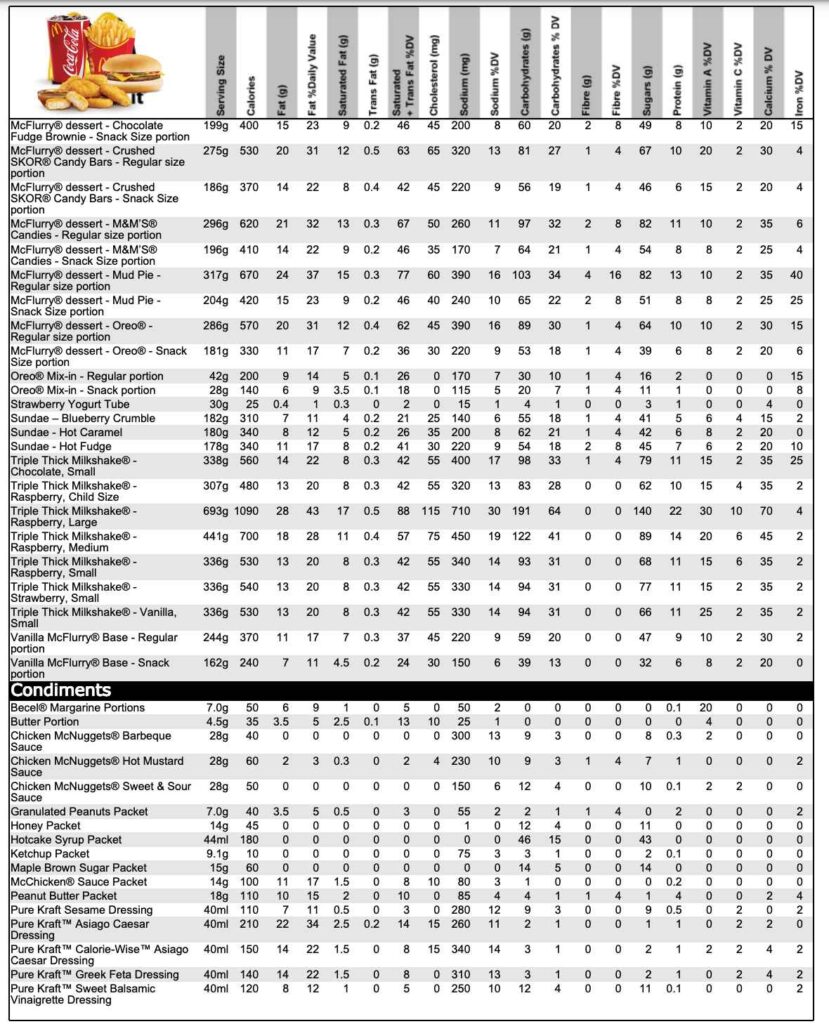In an era where health and well-being are paramount concerns, access to accurate and comprehensive nutrition information, such as McDonald’s Nutrition, is crucial for consumers. People are increasingly interested in making informed choices about their food, not only for maintaining a balanced diet but also for addressing specific dietary needs and preferences. When it comes to a ubiquitous fast-food chain like McDonald’s, understanding McDonald’s Nutrition, including McDonald’s Nutrition Canada, and accessing detailed McDonald’s Nutrition Facts becomes essential for individuals striving to make conscientious decisions about their meals. This information empowers consumers to tailor their orders to suit their nutritional goals and dietary requirements, ensuring that a visit to McDonald’s can align with a healthier lifestyle.
Nutrition information empowers consumers to:
- Manage Their Health: Knowledge about the nutritional content of menu items allows individuals to make choices that align with their health goals, whether it’s calorie control, reducing fat intake, or managing sodium levels.
- Accommodate Dietary Restrictions: For those with allergies, sensitivities, or dietary restrictions (e.g., vegetarians, vegans, gluten-free diets), understanding the ingredients and nutritional values of menu items helps in making safe and suitable selections.
- Promote Balanced Eating: Nutrition information can aid in building well-rounded meals by considering factors like protein intake, fiber, and essential nutrients.
- Control Portions: Awareness of portion sizes helps consumers avoid overeating and maintain a healthy balance between calorie intake and energy expenditure.
- Evaluate Meal Choices: It enables consumers to evaluate the nutritional trade-offs between different menu items and make choices that align with their preferences.
The purpose of this article is to offer a comprehensive and accessible resource that sheds light on the nutritional aspects of McDonald’s menu items in Canada. With this information, readers will be better equipped to make informed decisions about their food choices when dining at McDonald’s outlets across the country.
This content will delve into the nutritional content of various menu items, discuss special dietary considerations, provide tips for healthier choices, and offer guidance on customizing orders to fit individual preferences. By the end of this resource, readers will have a clearer understanding of how to navigate McDonald’s menu in Canada while considering their nutritional needs and dietary goals.
McDonald’s Nutrition Facts Canada
McDonald’s in Canada offers a diverse and extensive menu, catering to a wide range of tastes and preferences. From classic favorites to innovative creations, their menu is designed to provide something for everyone. Whether you’re looking for a hearty burger, a satisfying breakfast, a fresh salad, or a tasty snack, McDonald’s has you covered.
Breakfast:
| Item | Calories Range |
|---|---|
| Bacon ‘N Egg Bagel | 560-600 calories |
| Bacon ‘N Egg McMuffin | 310 calories |
| Bacon, Egg & Cheese McGriddles | 400 calories |
| Bagel with Butter | 300-320 calories |
| Bagel with Cream Cheese | 370-390 calories |
| Big Breakfast | 640 calories |
| BLT Bagel | 480-520 calories |
| Breakfast Burrito | 280 calories |
| Chicken McMuffin | 360 calories |
| Egg LT Bagel | 460-490 calories |
| Egg McMuffin | 290 calories |
| English Muffin with Butter | 170 calories |
| Fruit & Maple Oatmeal | 290 calories |
| Hash Browns | 160 calories |
| Hot Caramel Sundae | 340 calories |
| Hotcakes with Syrup & Butter | 600 calories |
| More-Ning McWrap | 430-710 calories |
| Muffin | 360-430 calories |
| Sausage ‘N Egg McMuffin | 430 calories |
| Sausage McGriddles | 400 calories |
| Sausage McMuffin | 370 calories |
| Sausage, Egg & Cheese McGriddles | 520 calories |
Burgers:
| Item | Calories Range |
|---|---|
| Bacon & Cheddar Angus | 770 calories |
| Bacon ‘n Crispy Onion Quarter Pounder | 680-900 calories |
| Big Mac | 520 calories |
| Big Mac Bacon | 630 calories |
| Cheeseburger | 290 calories |
| Double Big Mac | 680 calories |
| Double Big Mac Bacon | 800 calories |
| Double Cheeseburger | 420 calories |
| Double Quarter Pounder | 650-740 calories |
| Double Quarter Pounder BLT | 890 calories |
| Double Western BBQ Quarter Pounder | 850 calories |
| Hamburger | 240 calories |
| McDouble | 370 calories |
| Mighty Angus Original | 790 calories |
| Montreal Steak Spice BBQ Angus | 710 calories |
| Quarter Pounder | 420-520 calories |
| Quarter Pounder BLT | 600 calories |
| Western BBQ Quarter Pounder | 630 calories |
Chicken McNuggets:
| Item | Calories Range |
|---|---|
| Chicken McNuggets | 170-830 calories |
Desserts:
| Item | Calories Range |
|---|---|
| Baked Apple Pie | 270 calories |
| Cadbury Creme Egg McFlurry | 420-630 calories |
| Chocolate Triple Thick Milkshake | 560-1160 calories |
| Hot Fudge Sundae | 340 calories |
| M&M’s McFlurry | 410-620 calories |
| Oreo McFlurry | 340-570 calories |
| Shamrock Shake | 500-1120 calories |
| Skor McFlurry | 370-540 calories |
| Squishmallows McFlurry NEW | 400-620 calories |
| Strawberry Triple Thick Milkshake | 550-1130 calories |
| Strawberry Yogurt Tube | 25 calories |
| Vanilla Ice Cream Cone | 240 calories |
| Vanilla Triple Thick Milkshake | 540-1110 calories |
Happy Meals:
| Item | Calories Range |
|---|---|
| Cheeseburger Happy Meal | 660 calories |
| Chicken McNuggets Happy Meal | 340 calories |
| Chicken Snack Wrap Happy Meal | 370-440 calories |
| Hamburger Happy Meal | 390 calories |
| Hotcakes Happy Meal | 520 calories |
Salads:
| Item | Calories Range |
|---|---|
| Caesar Side Salad | 150 calories |
| Garden Fresh Side Salad | 40 calories |
| I’m Greek-ing Out Salad | 310-440 calories |
| Keep Calm, Caesar On Salad | 390-520 calories |
Sandwiches & Wraps:
| Item | Calories Range |
|---|---|
| Chicken & Bacon Signature McWrap | 500-600 calories |
| Chicken Big Mac | 610 calories |
| Chicken BLT Sandwich | 560-700 calories |
| Chicken Caesar McWrap | 430-570 calories |
| Chicken, Tomato & Mozzarella Sandwich | 500-640 calories |
| Chipotle Chicken Snack Wrap | 240-290 calories |
| Double Filet-O-Fish | 560 calories |
| Filet-O-Fish | 400 calories |
| Junior Chicken | 370 calories |
| McChicken | 470 calories |
| McCrispy | 520 calories |
| McCrispy Bacon Deluxe | 590 calories |
| Ranch Chicken Snack Wrap | 240-290 calories |
| Southern BBQ Sandwich | 500-640 calories |
| Spicier Szechuan McChicken | 490 calories |
| Spiciest Ghost Pepper McChicken | 490 calories |
| Spicy Habanero McChicken | 470 calories |
| Sweet Chili Signature McWrap | 420-520 calories |
Sides:
| Item | Calories Range |
|---|---|
| Apple Slices | 40 calories |
| Brownie RMHC Cookie | 140 calories |
| Chewy Oatmeal Caramel RMHC Cookie | 160 calories |
| Chocolate Chunk RMHC Cookie | 160 calories |
| French Fries | 120-560 calories |
| Poutine | 510 calories |
| Spicy Buffalo Chicken Poutine | 1020 calories |
McDonald’s menu in Canada features a variety of options across different categories. Their burgers are a hallmark of their menu, with classics like the Big Mac, Quarter Pounder, and Cheeseburger. Additionally, there are various sandwich options, such as the McChicken, Filet-O-Fish, and Grilled Chicken Sandwich, offering a range of flavors and textures.
For those seeking lighter fare, McDonald’s offers a selection of salads that incorporate fresh ingredients like mixed greens, vegetables, and grilled chicken. These salads can be a nutritious choice for individuals looking to incorporate more greens into their meal.
The breakfast menu at McDonald’s is also noteworthy, with offerings like Egg McMuffins, hotcakes, breakfast burritos, and oatmeal. These items provide a convenient and satisfying start to the day, with options that cater to different tastes and dietary preferences.
Complementing their food menu, McDonald’s offers a variety of beverages, including soft drinks, coffee, tea, milkshakes, and fruit smoothies. These beverage options allow customers to quench their thirst and find a refreshing accompaniment to their meals.
McDonald’s in Canada recognizes the growing demand for vegetarian and vegan options and has expanded its menu to include plant-based offerings. The popular McPlant burger is a delicious vegan alternative to the classic burger, made with a Beyond Meat patty and served on a sesame seed bun with all the traditional toppings. This option provides a flavorful and satisfying choice for individuals following a vegan lifestyle or those who simply want to incorporate more plant-based options into their diet.
Additionally, McDonald’s offers vegetarian options like the Veggie Deluxe burger, which features a patty made with vegetables, cheese, lettuce, and tomato. These vegetarian choices provide alternatives for customers who prefer not to consume meat.
McDonald’s Nutritional Information
The Nutrition Facts table is a standardized format used by McDonald’s and other food manufacturers to provide detailed information about the nutritional content of their products. It is typically displayed on the packaging or available through other means, such as on their website or mobile app.
The Nutrition Facts table is organized into specific sections, making it easier for consumers to understand and compare the nutritional values of different food items. It includes information about serving size, calories, macronutrients (fat, carbohydrates, protein), micronutrients (vitamins and minerals), and sometimes additional details about specific nutrients or ingredients.
Breakdown of key components, such as serving size, calories, macronutrients (fat, carbohydrates, protein), and micronutrients (vitamins and minerals)
- Serving size: This indicates the recommended portion size of the food item and is typically presented in common household measurements (e.g., grams, cups, or pieces).
- Calories: This represents the amount of energy provided by one serving of the food item. It is an essential factor to consider when managing calorie intake and maintaining a balanced diet.
- Macronutrients:
- Fat: The amount of fat (in grams) in a serving of the food item, including both saturated and trans fats. It helps individuals track their fat intake and make choices that align with their dietary goals.
- Carbohydrates: The total amount of carbohydrates (in grams) present in a serving. It includes sugars, dietary fiber, and other complex carbohydrates.
- Protein: The quantity of protein (in grams) in a serving. Protein is vital for various bodily functions and plays a role in muscle development and repair.
- Micronutrients:
- Vitamins: The Nutrition Facts table may list certain vitamins, such as vitamin A, vitamin C, calcium, or iron, along with their respective amounts. These micronutrients are essential for overall health and well-being.
- Minerals: Similar to vitamins, minerals like calcium and iron may be included in the table, providing information about their presence and quantity in the food item.
Interpretation of % Daily Value (DV) and its significance in assessing nutritional content
The % Daily Value (DV) is a reference value based on the recommended daily intake of nutrients for an average adult. It helps consumers evaluate the nutritional content of a food item in the context of their overall diet.
The % DV indicates how much of a specific nutrient (e.g., fat, carbohydrates, protein, vitamins, or minerals) is present in one serving of the food item, relative to the recommended daily intake. For example, if a food item has 20% DV of fat, it means that one serving provides 20% of the recommended daily intake of fat for an average adult.
It’s important to note that the % DV is based on a 2,000-calorie daily diet, which may vary depending on an individual’s age, sex, and level of physical activity. The % DV values can be used as a general guide to compare the nutritional content of different products and make informed choices about their dietary intake.
A % DV of 5% or less indicates a low amount of a specific nutrient, while 15% or more signifies a high amount. Consumers can use the % DV to identify food items that align with their nutritional goals, such as selecting products with lower % DV of saturated fat or higher % DV of fiber.
It’s important to remember that the % DV is not a target but rather a reference point to understand the nutritional composition of a food item. Individual nutritional needs may vary, and it is advisable to consult with healthcare professionals or registered dietitians for personalized dietary recommendations.
McDonald’s Chicken Nuggets Nutrition
The nutritional information for a 6-piece serving of McDonald’s Chicken McNuggets:
- Calories: 261
- Fat: 16g (25% DV)
- Saturated fat: 2g (10% DV)
- Trans fat: 0g
- Cholesterol: 55mg (22% DV)
- Sodium: 420mg (17% DV)
- Total carbohydrates: 16g (6% DV)
- Sugars: 0g
- Protein: 15g
As you can see, Chicken McNuggets are a relatively high-fat and high-sodium food. They also contain some cholesterol, but not as much as you might think. The serving size is also relatively small, so if you’re only eating a few nuggets, the impact on your overall calorie intake won’t be too bad.
If you’re looking for a healthier option, you could try ordering your Chicken McNuggets without the dipping sauce. The sauce can add a lot of extra calories and fat, so it’s best to avoid it if you’re trying to watch your weight.
You could also try ordering the Chicken Selects instead of the Chicken McNuggets. Chicken Selects are made with white meat chicken, and they have a slightly lower fat content than Chicken McNuggets.
McDonald’s Menu Nutrition
Tips for calorie-conscious choices at McDonald’s
- Opt for smaller portion sizes: Consider choosing smaller-sized burgers or sandwiches to reduce calorie intake. For example, try a regular hamburger instead of a double cheeseburger.
- Choose grilled or baked options: Look for menu items that are grilled or baked instead of fried. Grilled chicken or fish sandwiches can be lower in calories compared to their fried counterparts.
- Load up on vegetables: Incorporate more vegetables into your meal by choosing options like salads or adding extra lettuce and tomatoes to your burgers. This can help increase the volume of your meal without adding excessive calories.
- Select water or unsweetened beverages: Opt for water, unsweetened iced tea, or diet sodas instead of sugary drinks to reduce calorie intake from beverages.
Strategies for reducing fat, sugar, and sodium intake
- Request sauce and dressing on the side: This allows you to control the amount you use, reducing added fat and calories.
- Choose lower-fat protein options: Opt for grilled chicken or fish instead of fried options, as they tend to be lower in fat.
- Customize your order: Ask for no cheese or mayo on your burgers or sandwiches to reduce fat content. You can also request less salt or no added salt to reduce sodium intake.
- Limit sugary toppings and extras: Consider reducing or omitting high-sugar toppings like caramel or chocolate sauces, whipped cream, or sugary syrups.
Understanding the importance of balanced macronutrient consumption
- Include protein in your meal: Protein is essential for muscle repair and satiety. Look for options that contain lean protein, such as grilled chicken or fish, to help balance your meal. 2. Incorporate whole grains: Choose whole grain buns or wraps for your burgers or sandwiches to increase fiber intake and promote better digestion.
- Don’t forget about fruits and vegetables: Add a side of fruit or a side salad to your meal to increase the nutrient density and fiber content.
- Moderate your carbohydrate intake: While carbohydrates provide energy, it’s important to be mindful of portion sizes. Consider opting for smaller-sized fries or sharing them with others.
By implementing these strategies, you can make more informed choices when dining at McDonald’s, managing your calorie intake, reducing unhealthy fats, sugars, and sodium, and striving for a balanced macronutrient consumption. Remember that balance and moderation are key, and it’s always beneficial to listen to your body’s hunger and fullness cues.
Special Dietary Considerations
Addressing common dietary needs, such as gluten-free, dairy-free, and nut-free options McDonald’s recognizes the importance of catering to individuals with special dietary needs. While they may not have dedicated gluten-free or allergen-free kitchens, they offer options that can accommodate certain dietary restrictions. For example, their grilled chicken patties and certain salads may be suitable for those following a gluten-free diet. Additionally, McDonald’s provides information about common allergens present in their menu items, such as milk, eggs, soy, wheat, fish, shellfish, peanuts, and tree nuts.
Discussing the availability of allergen information to accommodate food sensitivities and allergies
McDonald’s acknowledges the significance of allergen information for individuals with food sensitivities or allergies. They strive to provide comprehensive allergen information, both online and in-store, to help customers make informed decisions. Allergen information is typically available on their website, mobile app, or through customer service channels. It is important for individuals with food allergies or sensitivities to review this information and consult with restaurant staff about specific concerns to ensure their safety and well-being.
Healthy Choices and Balanced Eating
McDonald’s is committed to offering a range of healthier choices to their customers. They have introduced initiatives such as the “McDonald’s Balanced, Active Lifestyles” program, which focuses on providing nutritious options and promoting physical activity. They have also made efforts to reduce sodium, sugar, and saturated fat in their menu items.
Identifying lower-calorie and nutrient-dense menu items: McDonald’s offers a variety of menu items that can be part of a balanced and healthy diet. For example, grilled chicken wraps, salads with lean protein options, and breakfast items with egg whites are lower in calories and provide essential nutrients. By choosing these options and being mindful of portion sizes, customers can enjoy nutritious meals at McDonald’s.
Encouraging balanced meals with fruits, vegetables, and whole grains: McDonald’s encourages the inclusion of fruits, vegetables, and whole grains in meals. Customers can opt for side salads, apple slices, or oatmeal as healthier alternatives to complement their main course. These choices contribute to a balanced and nutrient-rich meal.
Customization and Nutritional Impact
Exploring the impact of customization on nutritional content: McDonald’s offers customization options to accommodate individual preferences and dietary needs. Customizing menu items by omitting certain ingredients or requesting modifications can affect the overall nutritional content. Customers can choose to reduce added sugars, fats, or sodium by making informed choices during the ordering process.
Providing guidance on making healthier modifications to menu items: Customers can make healthier modifications to menu items by opting for grilled instead of fried options, choosing smaller portion sizes, or requesting dressings or sauces on the side. These modifications can help reduce calorie and fat intake while still enjoying a flavorful meal.
Discussing the importance of portion control and mindful eating: Portion control and mindful eating are essential for maintaining a balanced diet. McDonald’s provides options like Happy Meals with controlled portion sizes for children. By being aware of portion sizes and listening to hunger and fullness cues, customers can enjoy their meal while practicing moderation.
Transparency and McDonald’s Commitment
Detailing McDonald’s commitment to transparency in providing nutrition information: McDonald’s is committed to transparency and providing accurate nutrition information to their customers. They strive to make nutrition facts easily accessible through various channels, ensuring that individuals can make informed choices based on their dietary needs and preferences.
Describing their initiatives for continuous improvement in menu options: McDonald’s is continuously working to improve their menu options, focusing on reducing sodium, saturated fat, and added sugars. They explore new ingredients, cooking techniques, and partnerships to develop healthier offerings that meet customer expectations.
Mentioning collaborations and partnerships to support healthier food choices: McDonald’s collaborates with health organizations, nutrition experts, and suppliers to enhance their menu offerings and promote healthier food choices. They actively engage in partnerships to develop new products and initiatives that align with evolving consumer preferences and health recommendations.
Accessing McDonald’s Nutrition Facts
Discussing multiple channels for obtaining nutrition information (website, mobile app, in-store): McDonald’s provides nutrition information through multiple channels for customer convenience. Customers can access detailed nutrition facts on their official website, mobile app, or in-store through brochures or pamphlets.
Explaining how to use the online nutrition calculator for customized meal planning: McDonald’s offers an online nutrition calculator that allows customers to customize their meal choices and calculate the nutritional content accordingly. This tool helps individuals plan their meals based on their specific dietary needs and preferences.
Highlighting the availability of printed brochures or pamphlets in-store: McDonald’s provides printed brochures or pamphlets in-store that contain comprehensive nutrition information. Customers can refer to these materials while ordering or take them home for future reference. These resources support informed decision-making and help individuals make choices that align with their dietary goals.
